We both slept great until 6:00 am. Got ready and had our breakfast - baguettes, soft cheeses, homemade jams, yogurt, cereals, apple coffee cake, coffee, and OJ. Delicious! Left the B&B to be in Bayeux center to meet our Battle Bus tour guide and the 3 other couples sharing the full day tour. Our tour guide Allan, was a knowledgeable Brit, who has studied the Normandy invasions for 25 years and is a historical writer.
Stop #1- Allan drove us to the small town of St. Mere Eglise, where some of the first airborne paratroopers landed. We visited the Airborne Museum and church square.
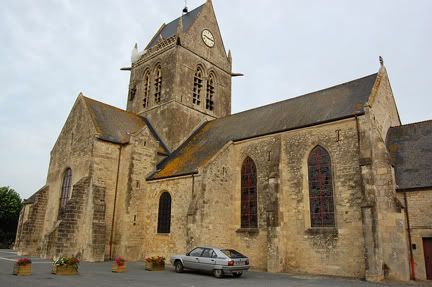
Stop #2 - the 11th century Norman church in the tiny village of Angouville-au-plain that became a medic station for injured paratroopers. Two American medics ran the station after parachuting into the area themselves. They treated Americans, French and Germans alike just as long as they checked their weapons at the door. They ran the aid station unassisted for 3 days until help arrived to take the wounded to hospitals, several died in the church. We sat in the old wooden pews, blood stains still visible. The church itself, had many of it’s original windows blown out, the bell tower bombed, and the back door rammed by a tank. The shell that took out the bell tower, landed and cracked the church floor, stayed intact, while one of the medics threw it out the window, never exploding.
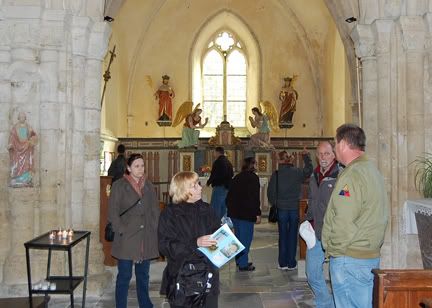
Stop #3 – Lunch stop at a small, sandwich shop owned by a British lady. We had a great ham and cheese baguette sandwich, bag of chips, candy bar, piece of fruit and a drink.
Stop #4 – Utah Beach, one of the smaller invasions beaches with the least amount of casualties. Here, there is a museum and lots of weapons and war junk displayed around the dunes.
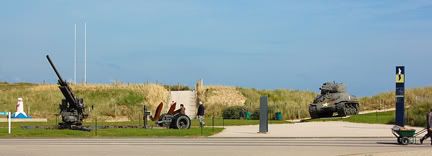
Stop #5 – Point du Hoc, the main German battery protecting the beaches from invasion. The German guns, armories, buildings, foundations of buildings, or what’s left still stand from that day. The beachy hills and dunes at the top of the cliff are pockmocked with craters from the American ship big guns and aerial bombing. Eliminating the armory would make for a successful invasion on Utah Beach.
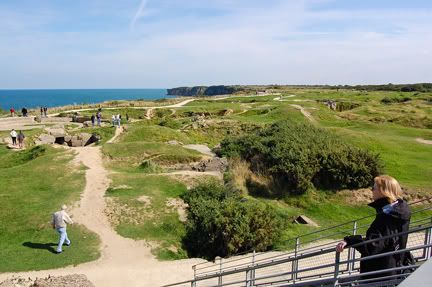
Stop #6 – Omaha Beach, the bloodiest battle of the Normandy Invasion. Allan told the stories of individual, first hand accounts from WW2 vets who survived that day. The crescent shaped beach had a battery at each end for flanking fire coming from both sides as well as from the Germans shooting from the top of the cliffs. The road at the top of the beach and barbed wire rolls were never depicted in any movie about The Normandy invasions. The majority of injured and deaths occurred on Omaha Beach.
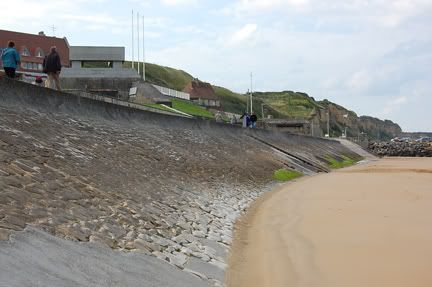
Stop #7 – The American cemetery, a very beautiful resting place high on the bluff overlooking the ocean, lined with marble crosses, perfectly in rows, in every direction. The trees that circle the graves, all have their tops lopped off straight across, to signify the cutting short of young lives. To see the over 9,000 crosses, of mostly 18-early 20 year olds, was mind boggling, moving, and a powerfully sad experience. Reading the names and hometowns brought a realization of their bravery and of their horrifying ordeal. As we started walking the graves, the color guard began taking our flag down from the flagpole, the bugler playing taps in the background . . . I lost it.
The cemetery is one of the few places outside the US considered US soil. The US Government runs the cemetery and hires the help as US employees even though they are French.
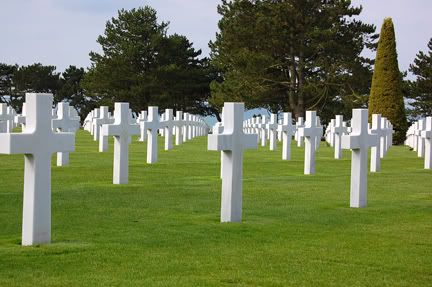
Photo slideshow from Day 2
This ended our tour at 5:30pm, and back to the town of Bayeux. We quickly visited the Tourist Info center for maps and ideas of places to visit on our free day tomorrow. Back to the B&B, to rest.

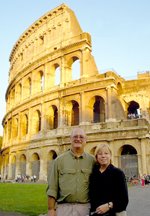


No comments:
Post a Comment